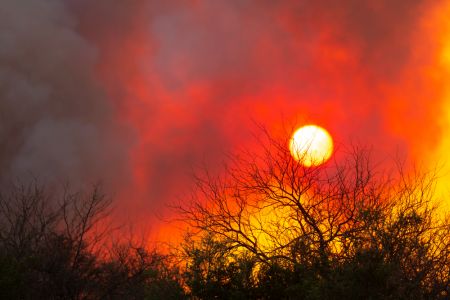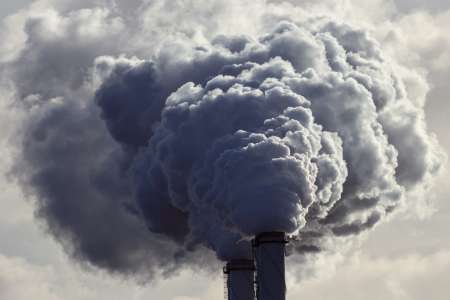Deforestation Is the Leading Cause of Habitat and Biodiversity Loss
As forests are cleared, fragmented, and degraded, ecosystems that have existed for millennia can collapse in just decades. The consequences are devastating. Entire species that have evolved over hundreds of thousands of years can vanish in the blink of an eye.
06/17/2024

The Ugly Reality of Deforestation
Deforestation for agricultural or commercial purposes is destroying natural habitats and ecosystems. It significantly contributes to biodiversity loss, climate change, and the release of large amounts of carbon dioxide into the atmosphere as the destroyed forests are burned. No species exists isolated from all others. All, including humans, depend on services that are derived from other species in a complex web of interdependency. Deforestation is hugely destructive of those relationships and imposes costs on all species.

Illegal mining causes deforestation and river pollution in the Amazon rainforest near Menkragnoti Indigenous Land. – Pará, Brazil. iStock.com/Marcio Isensee e Sa
Forest losses indeed occur from natural occurrences, such as diseases, fires, and droughts, but most forests today are destroyed by humans. All forests, but particularly tropical forests, are increasingly the target of devastation, destruction, and deforestation. According to the Boston Consulting Group (BCG), “Forests are disappearing at a rapid pace—we lose an area equivalent to 40,000 soccer fields every day.” The United Nations (UN) states, “The annual rate of deforestation was estimated at 10 million hectares between 2015-2020, compared with 12 million during 2010-2015.” Current estimates are that the figures have risen to 24.7 million acres.
Numbers alone do not paint a mental picture of how extensive the problem really is. Picture an area the size of the U.S. State of Virginia being destroyed worldwide every five years. In 40 years, at that rate, the amount of devastated forest area would equal almost half the land area of the continental United States. This continual, rampant destruction of forest areas over the past 60 years has greatly affected the world’s ecosphere on many levels and must be halted.
What Is Driving the Forest Losses?
In 2016, the Union of Concerned Scientists concluded that “Just four commodities—beef, soy, palm oil, and wood products—drive the majority of tropical deforestation.” Clearing lands for coffee, tea, sugar, and other commodities all add to the problem. As human populations soar, so do the demands for goods and services.
“Global demand for meat is growing, and over the past 50 years, meat production has more than tripled. The world now produces more than 340 million tonnes yearly,” as reported in the 2019 Meat and Dairy Production analysis by Our World in Data. The United States leads the world in per capita beef consumption, while countries in Asia, notably China, Japan, and South Korea, are now seeing huge increases in demand for and consumption of beef. To fill those needs, ever-increasing quantities of beef and other animal products are required and produced.

Since the 1960s, the cattle herd of the Amazon Basin has increased from 5 million to more than 70-80 million heads. Around 15% of the Amazon forest has been replaced, and around 80% of the deforested areas have been covered by pastures. iStock.com/Brasil2
Increasing herds of cattle are a good example of the interconnectivity in environmental issues. Cattle are ruminant animals, and their digestion processes produce methane. Put more succinctly, they produce a lot of gas. Methane, combined with other atmospheric gases, is a primary contributor to ozone depletion and causes about one million premature deaths yearly from respiratory illnesses.
The United States Environmental Protection Agency (EPA) states, “Methane is more than 25 times as potent as carbon dioxide at trapping heat in the atmosphere. Over the last two centuries, methane concentrations in the atmosphere have more than doubled, largely due to human-related activities.” It is a huge driver of global warming, which impacts forests worldwide. As forests are damaged, the viability of species that reside in the remaining forests declines, and weather conditions, such as droughts, are intensified, further driving forest destruction.
The circle is pretty clear. Replacing forests with cows increases atmospheric methane. This results in more global climate change and less mitigation of it because the forests are gone. Forest-favorable climates disappear along with species that support the forests, and even more, forests are threatened and disappear. It’s one example of millions showing the interdependence we all share, and one that circles around and around, affecting the forests, ecosystems, and us.
The High Costs of Losing Our Forests
As the “lungs of the planet,” forests are indispensable in removing and storing the huge amounts of CO2 that man is currently introducing into the climate. The London School of Economics and Political Science (LSE) reports that forest destruction accounts for 12-20% of greenhouse gases being released into the atmosphere.
Even degradation, without the total destruction of forests and tropical peat bogs, causes some tropical forests to emit more carbon than they currently absorb. When they are destroyed, we lose those benefits, and climate change worsens. Equally important is that forests have stored massive amounts of carbon. When they are destroyed, the carbon accumulated over decades and centuries is released into the atmosphere, creating a climate change greenhouse effect that traps heat and causes the Earth’s temperature to rise.
Deforestation contributes to other long-term environmental changes, such as oxygen production, temperature and humidity levels, and water cycle regulation. When these important benefits are no longer present, droughts, floods, and other extreme weather conditions driven by climate change are more regularly seen and more intense.
Climate change and deforestation drive losses of species diversity, and even when replaced by replanted, monoculture forests, the services they provide us and the losses of biodiversity are not restored. This is important because species population losses and extinctions cannot be ignored. All, when gone, were part of global diversity, and all losses affect all species worldwide, including people.
Wildlife denied jungle homes in their previous forest habitats and are forced into closer contact with humans. This results in conflict as competition for the same resources occurs, the spread of disease, loss of social norms that lead to the displacement of indigenous peoples, as well as declines in local economies that depend on forestry products. People existing in these situations have no means to support themselves, drive political and financial instability, and force migration. Problems that are increasingly seen all over the world.
Clearly, deforestation has a worldwide range of negative impacts, including driving costs incurred to mediate the negative effects it brings.
Here Is How You Can Make a Difference
1.) Understand and accept the evidence that deforestation, climate change, and the extinction of species are harbingers of truly horrible things to come. Deforestation is one of the downward spirals that are affecting our lives. Deforestation and climate change are complex and formidable issues that will take everyone’s efforts to solve, but they can be addressed if they are addressed soon.
2.) Recognizing them allows you to inform others of the issues, how they are harming us even now, and how we can work to defeat them. Informing the next generations who will need to be on board in efforts to mitigate the issues is crucial. They will be the ones most facing the devastation. Educating others about the importance of protecting our environment and how they can help make a difference will make a difference. Raising awareness about the issues can encourage more people to change their lives to help preserve our planet for future generations.
3.) Help protect the forests we still have and plant new ones, which help absorb carbon dioxide, improve soil fertility, and help increase species diversity.
4.) Burning fossil fuels releases greenhouse gases into the atmosphere, contributing to climate change. By replacing fossil fuels with renewable energy sources such as solar and wind power, we can help slow down the progression of climate change and the problems it creates for many forested areas and us. Becoming eco-friendly in your energy use will help.
5.) Change habits that you may have that contribute to the loss of forests, such as using one-use paper products. Switch to electronic billing and statements. Recycle paper and wood when possible instead of sending it to landfills. Look for the recycling symbol on products to ensure that they’re made from recycled materials.
6.) Support organizations like the Rainforest Alliance, the Forest Stewardship Council, the Rainforest Trust, and many other trusted organizations. They provide extensive information on the causes and effects of deforestation, as well as ways to get involved in forest conservation. These websites offer many tips for reducing your environmental impact, such as eating less meat, cutting down on paper use, and avoiding products made with palm oil. Many of the suggestions cost you nothing except changing a habit like not running water while brushing your teeth.
7.) Another great learning resource is the book “Drawdown: The Most Comprehensive Plan Ever Proposed to Reverse Global Warming” by Paul Hawken. The book includes contributions from some of the world’s leading scientists and offers various solutions for addressing climate change.
8.) Face the need to reduce global birth rates. Continuing the current population explosion will drive ever more demand for products. This is a recipe for disaster that will negate progress in conservation achievements.
9.) Ensure that you elect leaders who represent your values. Without leaders who are committed to ensuring that the planet will be habitable and a wonderful place to live, the future of humankind will be in jeopardy, and our children will live in a dystopian world. We can prevent that!
Amid these pressing challenges, there is an enduring beacon of hope. By taking actionable steps, each of us has the power to combat deforestation, preserve biodiversity, and reshape our planet’s future trajectory. Together, with concerted efforts and a unified vision, we can rise to the challenge and leave behind a world that thrives for generations to come. The choice is ours, and the time to act is now. Embrace the call to be stewards of our shared home, and let’s forge a legacy of resilience, sustainability, and harmony with nature.




















